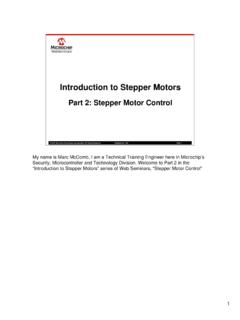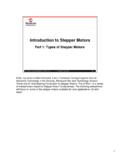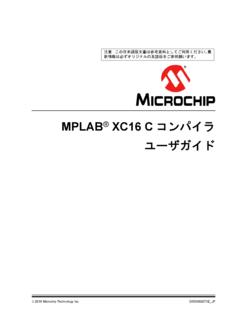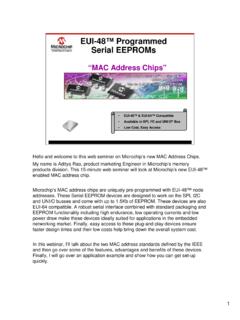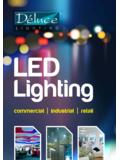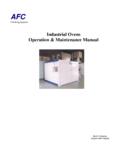Transcription of Welcome to the “Introduction to Controller Area …
1 1 Welcome to the introduction to Controller area network web seminar My name is William Stuart, and I am a Applications Engineer for the Automotive Products Group within Microchip. This web seminar today will last roughly 45 minutes and will provide you with a high level overview of CAN 2 2 Today s agenda starts with defining what CAN is I will then talk about the CAN Protocol We will cover key characteristics, details about Message Structure, and Error Handling next I will discuss in general terms how a PICmicro with the CAN model integrated transmits and receives CAN messages Finally I will close out this Web seminar with the Summary and point you to some Additional Resources to help you continue your path onto learning more about CAN 3 So What is CAN? CAN stands for " Controller area network and is defined in the ISO 11898 specification ISO 11898 is actually a family of specifications in which ISO11898-1 covers the datalink layer and ISO118980-2 and ISO118980-3 cover physical layers.
2 Just to name a few key characteristics about CAN CAN is extremely Robust communication Protocol. Here are three examples why Any CAN node on the BUS can detect errors in the message, and force the message to be destroyed and this feature helps to ensure that the message a node does receive contains valid data The CAN Frame requires that every node acknowledge the message before it can be processed by that node. This acknowledge can only come after various error condition checks; including a 15bit CRC on the message. If one CAN node finds an error with the message, the message is destroyed and retransmitted The specification defines three different error states for a CAN node to be in; with each error state giving the CAN node different levels of bus access. That was designed to limit faulty nodes from permanently taking down the CAN bus We will cover these features in more details later throughout the web seminar CAN is Serial communication in which All nodes on the CAN bus are attach to common connection using the same bitrate.
3 CAN is message based Not address based. What this means is Messages are NOT transmitted from one node to another node based on the address of a CAN Node. instead a CAN node will broadcast it s message to all nodes on the bus, and it is up to the receiving node to determine it should act on that message. Single or multiple nodes may act on the same data. It is possible to add New nodes to a CAN bus without having to update all of nodes with addressing information CAN allows for distributed control across a network because of the reliability of the data. This allows designers the flexibility to setup Master/Slave or Peer/Peer also called Consumer producer/networks 4 To give you a little bit of history on CAN Bosch originally developed CAN to address automotive network requirements to reduce the cost and weight of a vehicle wiring harness. This protocol was first released 1985. In the 1990s CAN was standardized by ISO 11898 Since then many Higher Layer Protocols (HLPs) were developed for and standardized on CAN: Both proprietary and non-proprietary protocols exist Today, CAN is found in almost every market while development is still continuing in the area of HLPs to support the needs of existing and new developers CAN continues to be widely popular mainly because it is an extremely robust, but also because the sheer volumes in the automotive market have driven the costs of a CAN node down.
4 This has allowed the protocol to grow rapidly since 1985 while expanding into other Markets like marine, industrial, and medical, Agricultural and construction, Military, Factory and Building automation. 5 5 Here I have shown the OSI 7 layer reference model. This model is a guideline for network developers that defines different levels that data should pass through to travel between two devices on the network And if you were to map the CAN protocol onto this model, you would see that CAN would exist in the lower two layers (Datalink and part of the Physical layer) And as for reference most HLPs would map to the upper 5 layers The ISO 11898-1 doesn t cover HLPs. It also doesn t specify what transceivers or connectors should be used for a CAN network 6 This slide shows a very simple CAN network . This example CAN network is made up of four nodes that are connected to a physical which in this example is a differential bus with termination.
5 Even though we are using a differential bus for this example keep in mind that other possible physical layers exist. ISO 11898-2 defines high speed physical. One important note is that Transmission speeds are defined up to 1 Mbps for total bus lengths of less than 40m Now it is possible to lengthen this distance in the CAN BUS, by to do so the bitrate would have to be lowered for the entire CAN network In this Example the Door Node will transmit out a message that lets the other nodes on the bus know that the state of the door (closed or open). While the door node is transmitting it is also receiving it s transmitted message at the same time as the other nodes on the BUS. All nodes including the Door Node are checking that message for errors. At a very basic level ALL CAN messages are broadcast messages If there are no errors with the message all nodes will ack the message by transmitting a dominant bit value onto the BUS while the Transmitting Node is listening.
6 This notifies the transmitter that at least one receiver validates the message. But even though all nodes were required to check the message for errors it is still possible that one node (In this case the Engine Node) doesn t care about the message and will discard it. The engine node has can implement two methods to discard this valid message. Both are implement during the design time of the Node. The first method is to configure the hardware mask / filters to discard the valid message before the user application is ever notified. The second method is to notify the user application of the message and allow it to make the filtering decision The first method is preferred when trying to prevent wasted CPU cycles, but there could be situations where it would make sense to have the application do the filtering. 7 There are various types of Nodes that can be found on a CAN network . Here I am showing three The node on the Left is an example of microcontroller that does not have an integrated CAN module, but the application requires that it still needs to connect to the CAN bus.
7 Typically you would see this with legacy applications that are now being requested by the network designer to be on the BUS or other reason would be the application requires a certain microcontroller that DOES not come with an integrated CAN module. In either case one of the simplest ways to this node to the CAN Bus is with standalone CAN module. The next type of node you will find on a CAN bus is in the center, and this is an example of a node that has a microcontroller with an integrated CAN module (Which allows for a faster internal connection between the CAN module and microcontroller). This is the most common node you would see on the CAN bus. Microchip currently provides 8/16/32 bit PIC micros with the CAN module integrated. The third example of a CAN node on the right shows a node with a CAN I/O expander This integrate circuit provides I/O expansion for a CAN network without a microcontroller This device would have peripheral like GPIO, A2D, or PWM The Node can be configure with defaults to send out messages periodic or event driven on thresholds Also other nodes can interact to read I/O or change Outputs This node requires No microcontroller firmware to write or debug, but then lacks some flexibility with non proprietary High Layer Protocols This device was designed for low cost simple sensor applications.
8 As you can see CAN nodes can execute very simple or complex applications 8 Now we will discuss what the various CAN frames exist in the ISO-11898 specification 9 9 Now lets take a look at the data frame As you can see there are two formats to this frame; Standard and extended. The major differences between the two formats is the Arbitration field. The standard frame has an 11 bit id in the arbitration field that allows up to 2048 unique messages onto the BUS And the extended frame has a 29 bit id that allows up over 536 million unique messages onto the BUS Both standard and extended data frames can coexist on the same CAN BUS. The standard 11 bit data frame will always have priority over the same extended 29 bit frame with identical 11bit base id. It is recommend that no two nodes transmit the same data frame in terms of because this would break the arbitration process. So lets take a closer look at the data frame, we will use the standard for this deep dive The data frame starts with a Start of Frame which is a dominant Next comes the ID this is where the arbitration occurs and the node with the highest priority id (Lowest ID Number) wins the BUS.
9 So in other a Node transmitting out a data frame with ID 0 will always win access to the BUS a nondestructive bitwise arbitration method is use to allow multiple nodes to contend for the BUS. This process allows the highest priority message to remain intact even though there were collisions detected. And this process takes place without corruption or delay of the highest priority message. Which is one reason why CAN works great in safety critical applications. I will discuss arbitration more later. The node that wins arb will continue to transmit while all other transmitters will stop transmitting and revert to receiving nodes. Every node on the bus is responsible to check the message for errors that range from bit stuffing to CRCs error. So the transmitting Node will transmit out the control field that contains the IDE bit and data length code usually shorted to DLC. The IDE bit lets the receivers know if the message is standard or extended, while the DLC lets the receivers know if the message has between 0 and 8 data bytes.
10 Next the transmitting node will transmit out the data, then the CRC. The CRC is calculated from the SOF to the Data Field At the ack field the transmitter transmits a recessive bit on the bus and listens for a receiver to transmit a dominant. If up to that point there are no errors with this Data frame all receivers should transmit a dominant. This lets the transmitting node know that the receiving node received the message ok At the End of frame and three bits of quiet time; also called inter-frame space; all nodes including that node that just transmitted will have a chance to transmit again. Also note The ID of the message determines the priority and gives context to the information in the data field The highest priority ID is lowest numbered ID, so an standard data frame with an ID of 0 is the highest possible priority 10 10 Remote Frames can come in either standard or extended formats and contain No data payload.

